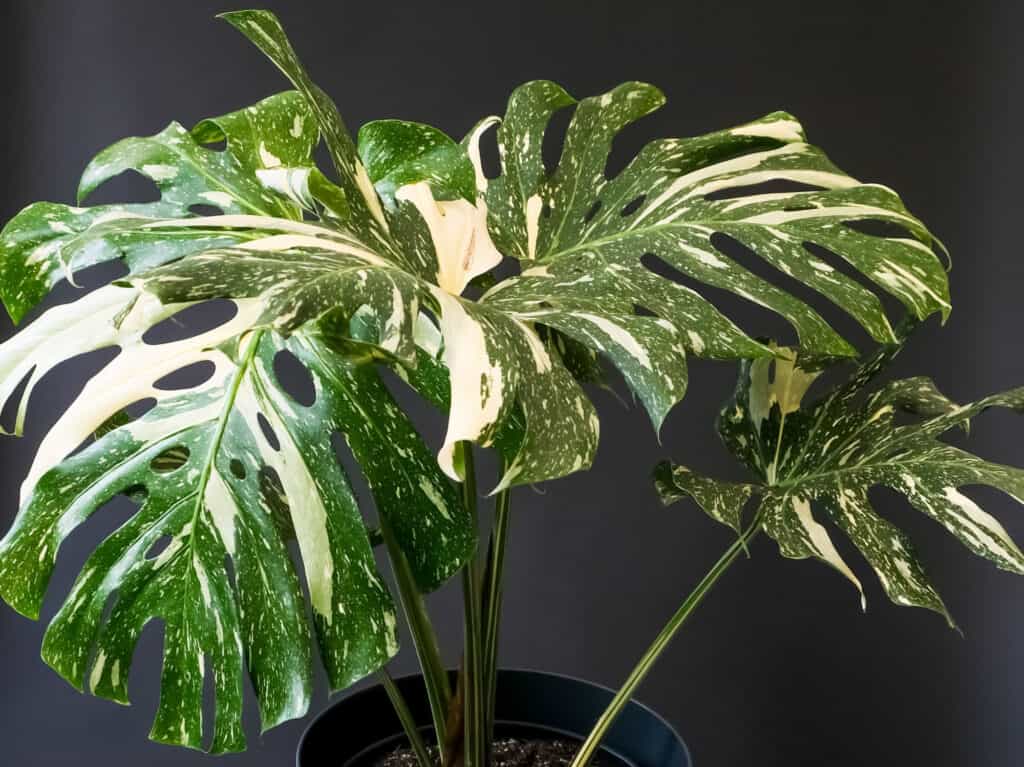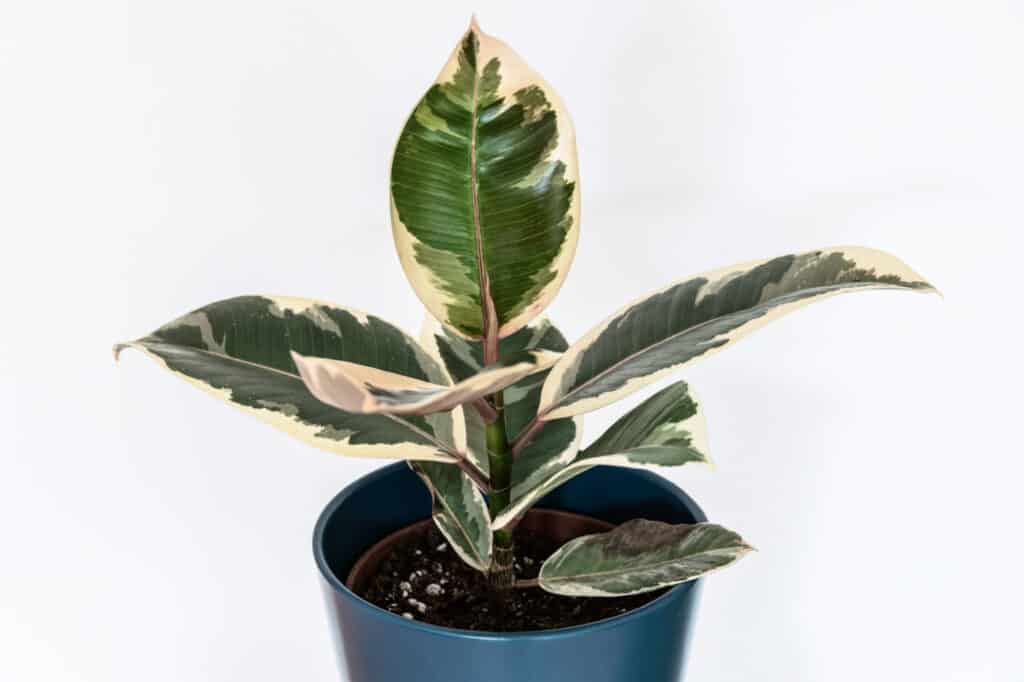There are a number of popular houseplants traded amongst influencers and plant fanatics, including albino monstera plants. Also known as white monstera deliciosas or monstera albos, albino monstera plants are difficult to come by. But you potentially find one of these expensive beauties, and perhaps other colors as well!
Read on to learn everything you need to know about albino monstera plants including what they are and how to best care for them. We’ll even give you some tips for how to purchase one of these elusive houseplants as well as some potential alternatives if you enjoy the appearance of white houseplants. Let’s get started!
Albino Monsteras: Are They Real?

While rare, there are some monsteras that grow white leaves.
©Natalia van D/Shutterstock.com
The idea of an albino monstera is a bit of a misnomer. No monstera cultivars are completely white or lacking in pigment, as chlorophyll is a necessary component of any monstera plant. However, there are variegated or differently-colored monstera plants available, no matter how rare or how hard to find they may be.
Most albino monstera plants are a variety of monstera deliciosa. Also known as the swiss cheese plant, Monstera deliciosa is a plant native to tropical regions of the world, which grows to unimaginable heights! However, white or variegated monstera deliciosa cultivars may take some time to reach the same heights as standard monstera deliciosa plants.
Meet the Monstera Albo
The monstera deliciosa ‘Albo Variegata’ or simply the monstera albo produces less chlorophyll compared to its green monstera deliciosa counterparts. This means that it grows at a slower rate and is much more difficult to propagate, given its lack of chlorophyll and means of growth. With all of this in mind, it’s no wonder that well-established monstera albo plants, particularly ones that are reliably cultivated, can sell for hundreds if not thousands of dollars!
As this plant’s rarity only heightens its popularity, it’s important to note that the monstera albo needs a bit more care than the average monstera deliciosa. Given its cost, it’s not recommended as a houseplant for beginners. Its delicate leaves and root system need to be protected from too much sunlight and too much water.
How Can I Find an Albino Monstera Plant?

Some variegated monsteras can grow speckled or all-white leaves.
©Dan Gabriel Atanasie/Shutterstock.com
Unfortunately, finding an albino monstera plant is easier said than done. Following specialty plant stores on social media as well as their individual shops is a good way to start. Only seek out reputable plant shops for variegated or white monsteras of any type, as scams exist throughout the plant sale world!
If you find a white monstera you wish to purchase, be sure you have a reasonable budget in mind. Most monstera albo plants cost more than you might expect and they sell quickly, given their popularity. Not only do you need to purchase this type of houseplant quickly, but you should also have a realistic sense of the budget needed to actually afford one to begin with!
Do Monsteras Come in Other Colors?
Monstera houseplants do not come in any other colors besides green and shades of white. However, there are some newly-developed cultivars that feature yellow patterns as well as different shades of green. You can even find monstera plants with speckles or spots of white, including rare cultivars with yellow stripes alongside white details!
Houseplant Alternatives to Albino Monsteras

The rubber tree comes in a white-leafed cultivar similar to the monstera albo.
©Maritxu/Shutterstock.com
If you feel disheartened to hear that albino monsteras are exceedingly rare and expensive, there are a few different alternatives to consider. Here are some houseplants that feature white leaves, relatively simple care, and a more attractive price tag:
- Epipremnum Aureum Pothos ‘N ‘Joy’. There’s no houseplant that brings more interest or ease of care than a pothos. These small-leaved plants trail and vine with a delicate appearance, perfect for any hanging pot or corner of your home. The ‘N’Joy’ cultivar produces white leaves and speckles throughout the green foliage, and it thrives in indirect light.
- Calathea Lietzei ‘White Fusion’. While calathea plants can have some fussy tendencies, the large and attractive leaves on this plant make it a favorite among houseplant experts. The ‘White Fusion’ cultivar produces marbled leaves in light green and white. Make sure to place this plant in an area where it will get the correct amount of light so you don’t lose variegation in its leaves!
- Fittonia Albivenis ‘White’. Also known as nerve plants, the white fittonia cultivar is dainty and attractive. Thriving in humidity, nerve plants work well in terrariums or bathrooms. They are also fairly easy to find year-round at your local garden center, so it’s worth trying to find!
- Ficus Elastica ‘Tineke’. Rubber trees produce large, glossy leaves and have fairly minimal care like monsteras. The ‘Tineke’ cultivar is no exception, and its leaves are muddled with white and pink accents. Mist daily to keep this humidity-loving houseplant happy!
Up Next
- Discover the Best Black Houseplants for Your Elegant Home
- 7 Best Books About House Plants That Will Stop You From Killing Them
- 10 Houseplants That Are Nearly Impossible to Kill
The photo featured at the top of this post is © Firn/Shutterstock.com
Sources
- Hyper-Recombinant Plants: An Emerging Field for Plant Breeding, Available here: https://www.tandfonline.com/doi/abs/10.1080/07352689.2021.1985819
- Comparison of green and variegated foliage plant species based on chlorophyll fluorescence parameters under different light intensities, Available here: http://www.esalq.usp.br/lepse/imgs/conteudo_thumb/COMPARISON-OF-GREEN-AND-VARIEGATED-FOLIAGE-PLANT-SPECIES-BASED-ON-CHLOROPHYLL-FLUORESCENCE-PARAMETERS-UNDER-DIFFERENT-LIGHT-INTENSITIES.pdf
Thank you for reading! Have some feedback for us? Contact the AZ Animals editorial team.






